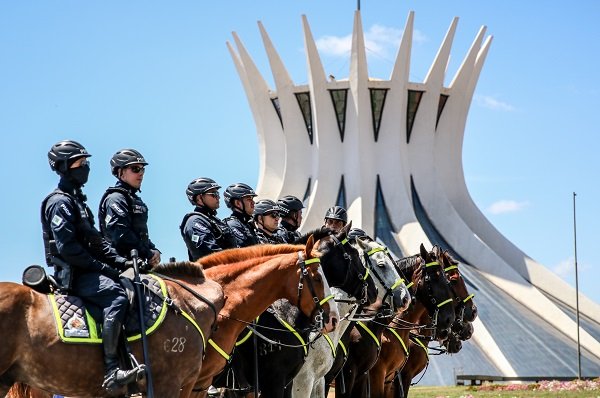The number of active military police officers (PMs) in Brazil fell 6.8% between 2013 and 2023, according to a study by the Brazilian Public Security Forum (FBSP) released on Tuesday (27/02). The number of civil and scientific police officers fell by 2% in the same period. According to the survey, in 2023 there were 404,871 active PMs in Brazil, compared to 434,524 in 2013. And 113,899 civil and scientific police officers, compared to 116,169 in 2013.
This Content Is Only For Subscribers
To unlock this content, subscribe to INTERLIRA Reports.
The Military Police are responsible for overt and preventive actions to combat crime and preserve public order. The Civil’s function is to register and investigate reports of crimes. The Scientific department works in a complementary way to the Civil one and carries out examinations to find evidence in criminal investigations.
Population Grew
The decline in the number of active police officers goes against population growth. Between 2010 and 2022 – years of the last two editions of the IBGE (Brazilian Institute of Geography and Statistics) Census – the Brazilian population grew by 6.5%.
Deficit
The most numerous police force in the country, the military police have a combined deficit of 179,591 officers. The civil police, operate with 55,244 fewer employees than expected.
This means that the two forces operate, respectively, with occupancy of 69.3% and 63% of the expected vacancies, according to information from state corporations and the Federal District. In total, the country has 404,871 PMs and 95,908 civil police officers.
Biggest Deficits
Considering the number of civil police forces, the deficit in the occupation of expected vacancies is more pronounced in Paraíba (23.8%), in Rio Grande do Norte (30.3%), and in Alagoas (39%).
Concerning the military police, the lowest occupations of planned positions are in Goiás (35.7%), Amapá (39.2%), and Santa Catarina (46.1%).
2 PMs per 1 thousand Inhabitants
The study points out that Brazil currently has on average, 2 PMs for every 1,000 inhabitants. Amapá (4.2), Roraima (3.9), and Distrito Federal (3.8) lead in the number of police officers per group of thousand inhabitants. Santa Catarina (1.3), Paraná (1.6), and Goiás and Maranhão (1.6 each) have the lowest amount.
Police by Area
There are also variations concerning the area. While, in Amazonas, there is 1 PM for every 189 km², in Santa Catarina (SC), there is 1 for every 1.3 km². and each Civil for every 835 km². On the Brazilian average, there is 1 PM for every 21 km².
Salary
Although there are no defined criteria for sizing and hiring the necessary staff in each state, the analysis of remuneration also highlights distortions in the country. A restricted group of 33,179 professionals —which amounts to 5.4% of the 620,018 professionals with available information— received, in 2023, remuneration above the constitutional ceiling, of R$39,293.
On the other hand, while they are responsible for at least 644 thousand prisoners in state penitentiary systems, penal police officers are the class with the worst average pay among security employees, with an average salary of approximately R$8,000.
Municipal Guards
In response to the decrease in the number of active police officers, municipalities have increasingly invested in municipal guards. The FBSP study shows that, in the last three years, the total number of Brazilian cities with a municipal guard increased by 23%, from 1,188, in 2019, to 1,467 in 2022.
Considering data from the Annual List of Social Information (Rais), from the Ministry of Labor and Employment, 34 cities had staff above that allowed by the 2014 Municipal Guards Statute — the limit depends on the size of the population of each city.
Analysis:
The way security is thought of by governments has become unfeasible in economic, fiscal, and social security terms. Police officers cost more than other employees in health, education, social assistance, and other areas of the executive.
The drop in the number of military and civil police officers in Brazil between 2013 and 2023 contrasts with the population increase in the same period. This reduction in the police force could have significant implications for the country’s public security, considering that these professionals work to prevent and combat crime.
Reductions in headcount over time can be largely attributed to cost pressure. The significant impact of pensions is reflected in expressive numbers, with more than 352 thousand retired police officers in the states and the Federal District. Replacing these professionals through admission processes becomes challenging.
One of the main consequences of this scenario is the low number of reports on investigative procedures, highlighting the difficulty of security forces in maintaining effectiveness in combating and solving crimes. The comparison between 2021 and 2022, the most recent years with available data, reveals a drop in this indicator in eight states and the Federal District.
Furthermore, in the last ten years, we have observed a decrease in the number of military police officers, while the number of municipal guards has shown growth. This response by municipalities to the decline in police forces, through increased investment in municipal guards, highlights the need to address security at local levels. However, it is crucial to ensure that these initiatives are complementary and do not replace the fundamental role played by state police.




